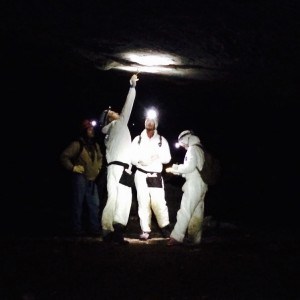Share this article
Are little brown bats developing resistance to white-nose syndrome?
In New York — the first state where the deadly white-nose syndrome was detected in 2006 — biologists recently made a surprising observation: some small populations of the little brown bat (Myotis lucifugus) are persisting.
This observation, first made in 2012, has prompted biologists to take a close look at the species that has been devastated by the fungal disease caused by Pseudogymnoascus destructans.
“This paper and others have shown that little brown bats, which were previously highly abundant in the Northeast, have begun to persist despite white-nose syndrome” said Kate Langwig, lead author of the study published in the journal Philosophical Transactions of the Royal Society B and now a postdoctoral fellow at Harvard T.H. Chan School of Public Health. Langwig studied the New York bats as part of her graduate work at the University of California Santa Cruz.

Researchers sample a bat to test for the fungus causing white-nose syndrome in a mine in the Midwest. ©J. Redell
But so far, biologists don’t have a good answer why the bats are surviving. “While they were persisting, it wasn’t clear how they were coping with the disease,” she said, adding that these reasons can provide clues to the long-term trajectories of these bat populations.
To uncover why the bats were persisting, Langwig and her colleagues compared the patterns of infection in little brown bats in New York to areas in Illinois and Virginia where the disease had more recently been detected and populations were declining.
As part of the study, Langwig and her team swabbed the bats’ skin and then conducted tests to detect the amount of the fungus they carry during winter hibernation. They used mathematical models to examine three major hypotheses for how bats were persisting with white-nose syndrome, including reduced transmission, tolerance, and resistance. The team found that bats in the New York populations seemed to reduce their fungal pathogen loads toward the end of their hibernation. However, during early hibernation the presence of the fungus appeared to be at similar levels to the populations that were suffering higher mortality, suggesting that bats had developed resistance to the disease.
Langwig and her team don’t fully understand the reason for this phenomenon, but they say there are a few possibilities that biologists might want to explore in the future. For example, there are some theories that the bats’ immune response is occurring very slowly and the benefits of their immune response aren’t shown until later in hibernation. Further, it’s possible that there’s some microbe on their skin that’s reducing the pathogen to lower levels.
“We don’t totally know, but these are some hypotheses we could be testing in the future,” she said. “Hopefully people will follow up on it.”
While the team only studied little brown bat populations in New York, Langwig says nothing is known about other species that may be developing resistance. For example, the northern long-eared bat (Myotis septentrionalis), which is listed as threatened under the Endangered Species Act, shows no indication of persisting during hibernation when the white-nose fungus is present, she says.
Langwig also says while little brown bats have been able to persist in New York, this might not be the case farther south. She suggests that climate and other conditions might play an important role for these persistence mechanisms to happen.
Header Image: Langwig examines a little brown bat for signs of white-nose syndrome outside a mine in New York. ©J.R. Hoyt








